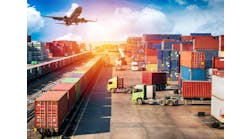President Donald Trump’s move to slap tariffs on at least $50 billion in Chinese imports is likely to be bad news for many of China’s exporters -- as well as Americans who like wearing Victoria’s Secret bras, Guess jeans or Nike sneakers.
A vast amount of items used by U.S. consumers -- from Under Armour leggings to Bath & Body Works shower gel and Samsonite luggage -- are sourced from Chinese or Hong Kong-based companies and factories, fueling the $450 billion in Chinese goods imported to America annually. Broad-based tariffs, which the U.S. said would be a 25% duty, may translate into higher sticker prices in stores across the U.S.
Retailers in the U.S. have pushed back, saying any such levies would amount to a tax on American consumers. In China, meanwhile, small exporters with a heavy reliance on the U.S. worry that their cost advantage could be wiped out in the global supply chain.
“That’s it then, we have no more competitive edge,” said Justin Yu, a sales manager at Zhejiang-based Pinghu Mijia Child Product Co., which makes toy scooters sold at American retailers. “I don’t know what we are going to do.”
The U.S. has yet to announce the list of products the additional duties will be levied on, but has said aerospace, information and communication technology will be targeted. Since consumer goods account for a large chunk of exports from China to the U.S., some Chinese manufacturers are preparing for the worst.
Yu said exports to the U.S. account for over $10 million of annual revenue for Pinghu Mijia, more than half of its total sales. “Chinese manufacturing has lost its advantage now, so we might as well find some other business to do,” he said.
Companies are already planning to raise prices if they are affected. If tariffs are raised on its products, Samsonite International SA chief executive officer Ramesh Tainwala sees one logical recourse. “We pass it on to the consumer,” said Tainwala, who spoke to reporters in Hong Kong last week. “We have the pricing power. We are the ones who will move first and the industry will follow."
Samsonite is in an unusual global position. While the world’s biggest luggage maker is based in Mansfield, Massachusetts, it is listed on the Hong Kong exchange. Samsonite executives say it manufactures two-thirds of its products in China and currently pays a tariff of more than 25% on them to the U.S.
The impact on other American companies would be widespread, fanning out across the U.S. because of the intricate links with international supply chains. Tariffs hitting one company in China can have a ripple effect across dozens of customers in the U.S. The connections are particularly strong across the apparel and technology industries.
Apparel and footwear, telecommunications equipment and household appliances are among the Chinese manufacturing sectors with the biggest exposure to the U.S. market, according to a Moody’s research note released on March 22..
Hong Kong-based Li & Fung Ltd. alone collects about two-thirds of its revenue from about 50 consumer-product companies in the U.S., including retailers Walmart Inc., Kohl’s Corp. and J.C. Penney Co. For Regina Miracle International Holdings Ltd., a Hong Kong-based manufacturer of intimate wear, American demand for lingerie makes up about 60% of revenue. Its customers include lingerie brand Victoria’s Secret.
Lenovo Group Ltd., the Beijing-based computer manufacturer, gets almost a third of its $43 billion in annual revenue from North America by selling its products to companies such as HP Inc. and Verizon Communications Inc.
Still, large Chinese companies like Li & Fung are likely to get some protection because of the diversity of their businesses and their international chain of suppliers. "With a global network of over 15,000 suppliers in over 40 markets, we are well-positioned to absorb in any shock from trade uncertainty," Li & Fung said. "We are unique in the industry, in that if there is any change in trade policy, we have the ability to channel production to any market quickly."
Other factors may also help insulate Chinese corporations. Many are still reliant on domestic consumers for revenue, reducing their exposure in the event of a trade war. The proportion of Chinese corporate revenue that comes from overseas is an average of only 8.8%, up from 6.6% in 2012, according to research from brokerage Natixis.
Chinese Tariffs
China retaliated on March 23 with reciprocal tariffs worth $3 billion on imports of U.S. pork, recycled aluminum, steel pipes, fruit and wine. Hong Kong-listed pork producer WH Group Ltd. -- which bought U.S-based pork giant Smithfield Foods in 2013 -- gets about 57% of its revenue from the U.S. It slid as much as 10% on March 23.
WH is assessing how to amend its strategy in response to the tariff, spokesman Luis Chein said. Its Smithfield operations in the U.S. currently export to 40 other countries in addition to China. “We do not think it will have a huge impact on our U.S. exporting business,” he said.
Closer to home in the U.S., smaller companies may feel the brunt of restrictive trade actions, according to Gary Huang, the Shanghai-based founder of consultancy 80/20 Sourcing. Multinationals with mature supply chains like Walmart could shift to Vietnam or India to avoid the tariffs, he said. On Amazon, more than half of product listings come from smaller businesses that source from China, which Huang said would be hit hard.
“These guys are going to be left holding the new tariff bill and those prices will go straight up,” Huang said. “This year’s Christmas could be a lot more expensive.”



